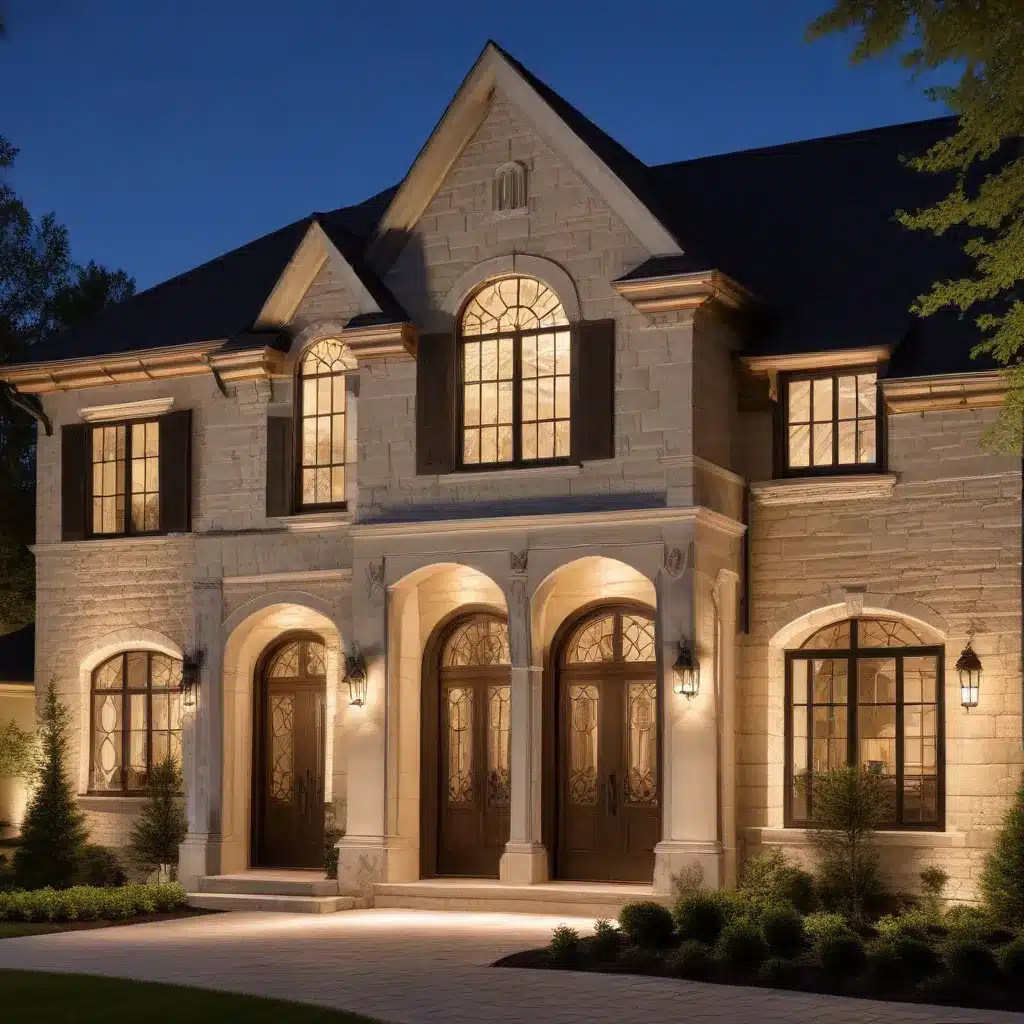
The Power of Facade Lighting Design
Have you ever wondered how some buildings captivate the eyes of viewers at night? The secret lies in the art of facade lighting design – the strategic use of light to accentuate a building’s architectural features and create a dynamic, memorable impression. As a seasoned construction professional and interior designer, I’m excited to share insights on leveraging lighting to elevate the beauty of any structure.
Facade lighting design is a complex and creative process that requires careful consideration of a building’s unique characteristics, its surrounding environment, and the desired aesthetic effect. The core principle is to highlight the distinctive architectural elements, whether it’s a historic landmark or a modern office complex. By illuminating these features with precision, you can elevate the overall appearance and identity of the structure, transforming it into a true work of art.
Mastering Light Levels and Color Temperatures
Light levels are a crucial factor in facade lighting design. It’s essential to strike the right balance – avoiding overly bright or intense illumination that can cause glare and detract from the details. Recommended luminance ranges vary depending on the building type:
- Residential buildings: 5-15 footcandles
- Commercial storefronts: 20-50 footcandles
- Monuments and landmarks: 10-30 footcandles
Equally important is the selection of color temperature. Warmer white light in the 3000K range creates a cozy, comfortable ambiance, while cooler shades around 5000K add contrast and vibrancy. The use of color-changing LED technology further expands the possibilities, allowing designers to dynamically alter the mood and personality of the facade.
Leveraging Strategic Light Placement
The strategic placement of lighting fixtures is crucial in achieving the desired effect. Uplighting from below the building casts a dramatic, depth-revealing glow, while downlighting minimizes shadows and glare. Grazing light across surfaces accentuates textures and adds dimension, and side lighting illuminates without overexposing certain areas. Flood lighting evenly washes the entire facade, while accent lighting spotlights specific details, entryways, or features. Combining these techniques ensures a balanced, visually captivating facade.
Adaptability to Building Materials
The success of facade lighting design also depends on understanding the unique properties of the building materials. Different surfaces, such as glass, stone, or brick, have varying reflectivity, transparency, texture, and color, all of which influence how light interacts with them. Adapting the lighting techniques and fixtures to the specific material characteristics is essential for achieving the desired aesthetic.
For example, modern glass and steel structures often benefit from cool white or colored LEDs in the 5000-6500K range, which create a sleek, vibrant contrast. On the other hand, stone and brick facades thrive with warmer color temperatures in the 3000-4000K range, which complement the inherent warmth and texture of the masonry. Facade grazing fixtures and wall washers can further enhance the tactile qualities of these materials.
Embracing Sustainability and Environmental Considerations
As a responsible construction professional, I believe that facade lighting design should not only be visually captivating but also environmentally conscious. Energy-efficient LED technology and smart lighting controls can significantly reduce energy consumption and minimize the environmental impact. Additionally, it’s crucial to consider the effect of lighting on wildlife and implement measures to mitigate any negative consequences.
Long-term maintenance of the lighting system is another key sustainability factor. Choosing high-quality, durable fixtures and incorporating easy-to-access maintenance strategies can ensure the facade lighting continues to shine brightly for years to come.
Highlighting Architectural Details: Practical Techniques
Now, let’s delve into some of the practical lighting techniques that can be used to accentuate a building’s architectural features:
Uplighting
Strategically placing fixtures on the ground and angling them upwards towards the facade creates a dramatic, depth-enhancing effect. This technique highlights textures, reveals architectural forms, and adds a sense of dimension to the building’s appearance.
Downlighting
In contrast to uplighting, downlighting uses fixtures placed above, angled downwards. This approach minimizes glare and shadows, but it requires careful consideration to avoid flattening the details and textures of the facade.
Accent Lighting
Focused on specific design features, architectural details, entryways, or signage, accent lighting creates a sense of hierarchy and draws attention to the most captivating elements of the facade. Adjustable fixtures allow for precise targeting of these key areas.
Grazing Light
Casting light across the surface of the facade at a shallow angle can accentuate textures, add depth, and reveal the subtle nuances of the building’s materials and forms.
Flood Lighting
Evenly washing the entire facade with light creates a balanced, cohesive appearance, while strategically placed accent lighting can then be used to highlight specific points of interest.
By combining these techniques, you can craft a facade lighting design that not only showcases the architectural beauty but also enhances the overall ambiance and mood of the building.
Transforming the Ordinary into the Extraordinary
As a construction professional and interior designer, I’ve witnessed firsthand the power of strategic lighting to elevate the aesthetic appeal of any structure. Whether you’re working on a historic landmark, a modern high-rise, or a commercial storefront, the right lighting choices can truly transform the ordinary into the extraordinary.
By carefully considering the building’s unique features, the surrounding environment, and the desired visual impact, you can create a facade that captivates the eyes of both occupants and passersby. The interplay of light and shadow, the strategic use of color, and the seamless integration of sustainable practices all contribute to a remarkable and memorable architectural experience.
So, the next time you embark on a facade renovation or new construction project, embrace the art of lighting design. Unleash your creative potential, collaborate with experienced professionals, and let the power of light elevate your work to new heights of architectural brilliance. Visit the Local Builder London website to explore more inspiring projects and connect with skilled builders who can bring your vision to life.


